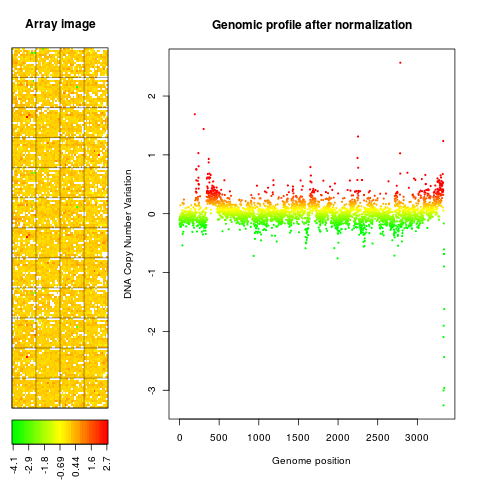Supported by Dr. Osamu Ogasawara and  providing providing  . . |
|
Last data update: 2014.03.03 |
Sorting for normalized arrayCGH objectsDescriptionSorts clone-level information of a normalized arrayCGH object. Usage
## S3 method for class 'arrayCGH'
sort(x, decreasing = FALSE, position.var="Position",
chromosome.var="Chromosome", ...)
Arguments
NotePeople interested in tools for array-CGH analysis can visit our web-page: http://bioinfo.curie.fr. Author(s)Pierre Neuvial, manor@curie.fr. See Also
Examplesdata(spatial) ## sort a normalized array by clone position gradient.norm <- sort(gradient.norm) report.plot(gradient.norm, main="Genomic profile after normalization") Results
R version 3.3.1 (2016-06-21) -- "Bug in Your Hair"
Copyright (C) 2016 The R Foundation for Statistical Computing
Platform: x86_64-pc-linux-gnu (64-bit)
R is free software and comes with ABSOLUTELY NO WARRANTY.
You are welcome to redistribute it under certain conditions.
Type 'license()' or 'licence()' for distribution details.
R is a collaborative project with many contributors.
Type 'contributors()' for more information and
'citation()' on how to cite R or R packages in publications.
Type 'demo()' for some demos, 'help()' for on-line help, or
'help.start()' for an HTML browser interface to help.
Type 'q()' to quit R.
> library(MANOR)
Loading required package: GLAD
######################################################################################
Have fun with GLAD
For smoothing it is possible to use either
the AWS algorithm (Polzehl and Spokoiny, 2002,
or the HaarSeg algorithm (Ben-Yaacov and Eldar, Bioinformatics, 2008,
If you use the package with AWS, please cite:
Hupe et al. (Bioinformatics, 2004, and Polzehl and Spokoiny (2002,
If you use the package with HaarSeg, please cite:
Hupe et al. (Bioinformatics, 2004, and (Ben-Yaacov and Eldar, Bioinformatics, 2008,
For fast computation it is recommanded to use
the daglad function with smoothfunc=haarseg
######################################################################################
New options are available in daglad: see help for details.
Attaching package: 'MANOR'
The following object is masked from 'package:base':
norm
> png(filename="/home/ddbj/snapshot/RGM3/R_BC/result/MANOR/sort.Rd_%03d_medium.png", width=480, height=480)
> ### Name: sort
> ### Title: Sorting for normalized arrayCGH objects
> ### Aliases: sort.arrayCGH sort
> ### Keywords: utilities
>
> ### ** Examples
>
> data(spatial)
>
> ## sort a normalized array by clone position
> gradient.norm <- sort(gradient.norm)
>
> report.plot(gradient.norm, main="Genomic profile after normalization")
>
>
>
>
>
> dev.off()
null device
1
>
|
